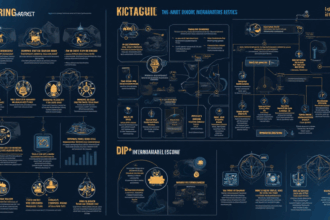Introduction
In 2024, a staggering $4.1 billion was lost to DeFi hacks, prompting a deeper examination of the mechanisms that support cryptocurrency networks. Among these mechanisms is the Bitcoin mining difficulty adjustment, which plays a critical role in maintaining the stability and security of the Bitcoin blockchain. Understanding how these adjustments work can provide insight into the broader implications for Bitcoin mining economics, user experience, and market dynamics.
At bitcryptodeposit, we aim to offer valuable knowledge on complex cryptocurrency topics, ensuring that users are equipped with the necessary tools to navigate this evolving landscape. This article will explore the nuances of Bitcoin mining difficulty adjustments and their impact on miners, investors, and the overall ecosystem.
What is Mining Difficulty Adjustment?
Bitcoin operates on a proof-of-work consensus mechanism, requiring miners to solve complex mathematical puzzles to validate transactions and add them to the blockchain. Mining difficulty adjustment is a process that occurs approximately every two weeks or every 2016 blocks. The primary goal is to ensure that blocks are added to the blockchain roughly every ten minutes, regardless of the total hashing power on the network. This adjustment is essential for maintaining the stability of the Bitcoin network.

When more miners join the network, the difficulty increases, making it harder to mine new Bitcoins. Conversely, if miners leave the network, the difficulty decreases, making it easier. This self-regulating mechanism is crucial to the long-term sustainability of Bitcoin as a digital asset.
How Do Changes Affect Miners?
- Profitability: As mining difficulty increases, potential profits may decrease for miners utilizing less efficient hardware. In a competitive landscape, profitability is often tied directly to efficiency and electricity costs.
- Hardware Upgrades: Miners may be forced to invest in better hardware to remain competitive, ensuring that they can continue to mine profitably.
- Network Security: A robust network with a high level of difficulty often translates to increased security. More miners mean more hashing power, which makes it harder for malicious entities to execute attacks.
Market Dynamics and User Experience
The adjustments in mining difficulty can have broad implications for market dynamics. When Bitcoin prices rise significantly, more miners might enter the network, leading to increased difficulty and potentially driving prices back down due to rising operational costs. This cyclical nature can create volatility in the market.
For users, changes in mining difficulty also affect transaction times and fees. When difficulty increases and fewer blocks are processed rapidly, transaction times may extend, and fees can rise. Users might prioritize higher fees to ensure their transactions are processed promptly—a dynamic that can create a frustrating user experience.
Impact on Bitcoin’s Future and Vietnam’s Growing Market
According to data from 2023, Vietnam saw a 25% increase in cryptocurrency users, indicating a burgeoning interest in digital assets. As the market matures, understanding the implications of Bitcoin mining difficulty adjustments becomes increasingly critical for both new and seasoned investors.
In Vietnam, users are particularly interested in how the mining landscape will evolve with potential regulatory developments. The government has begun exploring frameworks for cryptocurrency, which could significantly impact mining operations and overall user experience in the coming years.
The Challenges Ahead
- Environmental Concerns: Bitcoin mining is often criticized for its environmental impact due to high energy consumption. Discussions around sustainability are becoming central to future mining practices.
- Regulatory Impact: As governments like Vietnam seek to regulate the cryptocurrency space, miners may face additional challenges that influence their operational viability.
- Technological Advances: Innovations such as more energy-efficient mining rigs and renewable energy sources could reshape how mining difficulty impacts the ecosystem.
Conclusion
As we’ve explored, the impact of Bitcoin mining difficulty adjustments extends far beyond the technical details, affecting miners, market dynamics, and user experiences alike. With the growing interest in cryptocurrencies in Vietnam and around the world, understanding these nuances is essential for navigating future developments in Bitcoin mining.
At bitcryptodeposit, we remain committed to providing insights and resources for our users. Embrace the knowledge and stay ahead in the ever-evolving landscape of cryptocurrencies.
Expert Contributor
Dr. Alex Nguyen is a renowned blockchain researcher and author of over 20 published papers in the field. He has led audits for prominent projects and continues to shape discussions around cryptocurrency security standards.







